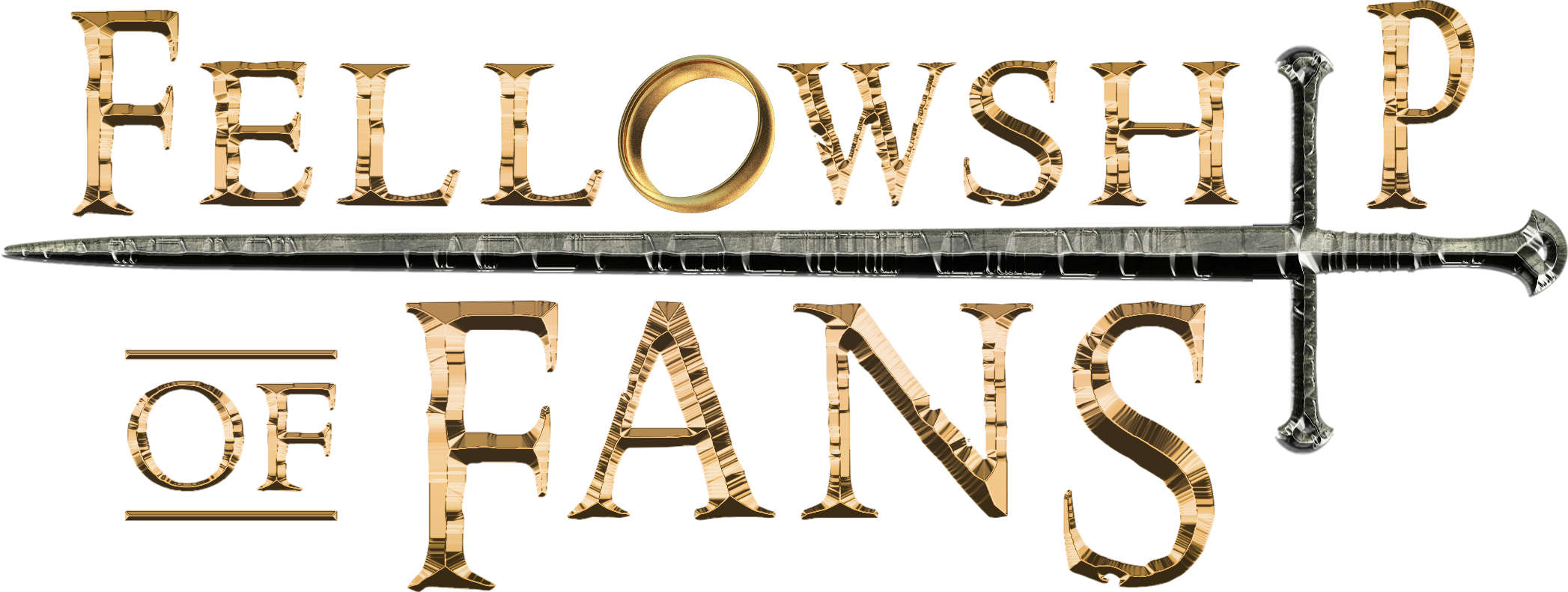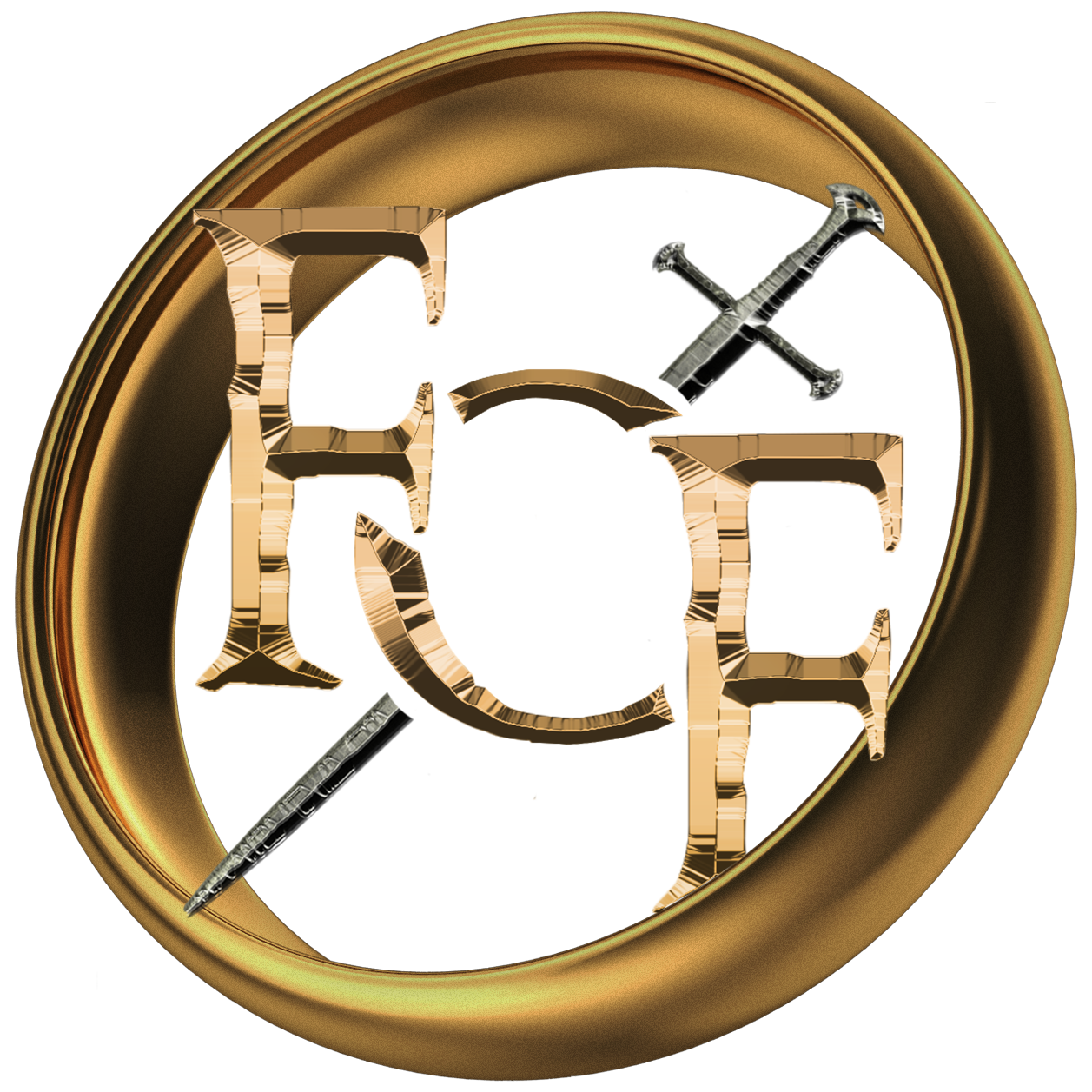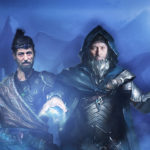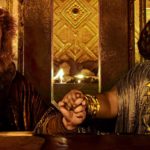
Dueling Canons
In The Return of the King, as the combined armies of Gondor and Rohan stand before the Black Gate, greatly outnumbered and completely encircled, the vast forces of Mordor closing in, Aragorn, Isildur’s heir, speaks these stirring words:
Hold your ground! Hold your ground! Sons of Gondor, of Rohan, my brothers, I see in your eyes the same fear that would take the heart of me. A day may come when the courage of men fails, when we forsake our friends and break all bonds of fellowship, but it is not this day. An hour of wolves and shattered shields, when the age of men comes crashing down, but it is not this day! This day we fight! By all that you hold dear on this good Earth, I bid you stand, Men of the West!
And then Aragorn turns to face the enemy, to the rising strains of Howard Shore’s “Fellowship” theme—for this scene is from the New Line films, and not something Tolkien wrote himself. It is a testament, either to the scriptwriting skills of Peter Jackson, Fran Walsh, and Philippa Boyens, or to the naivety of Men—if not both—that these and other words original to the New Line films can be found attributed to J.R.R. Tolkien in various places around the Internet.
It is not my purpose here either to criticize or defend Peter Jackson and company for diverging from the text of Tolkien’s works on numerous occasions. My point is simply that they do diverge from the text on numerous occasions. Or, to put it in terms familiar to those from some other fandoms, they contain much that is not “canonical”. I put the term “canonical” in scare quotes because I believe there is reason to question the usefulness of the terms “canon” and “canonical” with regard to Tolkien’s Legendarium. Nevertheless, as debates about canonicity rage, particularly around Amazon’s upcoming Rings of Power series, it may be useful to compare the Legendarium with other Secondary Worlds in which the term “canon” is perhaps more useful.
Canon: what is it?
The word “canon” comes from Latin, and from the Greek kanon before that. It is believed to ultimately come from a Semitic word meaning “reed”. (A related word came to mean “tube”, which then evolved into the word “cannon”.) In Greek and Latin the word meant “rod”, particularly a rod of standard length against which other things were measured. This word came to have a more figurative meaning as a “rule” or a “standard”. It came to acquire various ecclesiastical meanings in Medieval Christianity. However, probably the most relevant sense of the word for this discussion is Biblical canon. The Biblical canon consists of the writings regarded as Holy Scripture by a church. Other writings, which are not regarded as canonical for various reasons, are considered apocryphal.
In the present day the word “canon” has acquired a newer sense, meaning something like “a set of related literary works, films, television shows, etc., set in the same Secondary World, that have been officially approved by their creator(s) or their legal heirs, that are (presumably) fairly consistent, and upon which new licensed works set in the same Secondary World are expected to be based and not to egregiously contradict”. Something like this sense of the word seems to have appeared during Tolkien’s lifetime, in reference to stories about Sherlock Holmes. Nevertheless, the frequent discussions of canon within fandoms appears to be a fairly recent development. Tolkien himself used the word “canon” only three times in the collection of his letters found in The Letters of J.R.R. Tolkien. One reference is specifically to Roman Catholic religious rites. One is a man’s given name. And only one has anything whatsoever to do with creative works, though not really in the sense I have been using:
The canons of narrative in any medium cannot be wholly different; and the failure of poor films is often precisely in exaggeration, and in the intrusion of unwarranted matter owing to not perceiving where the core of the original lies.
Here the phrase “canons of narrative” just means “rules for writing good stories”, and has little to do with the term “canon” as it used in modern fandoms. The first clause in the quote above may be restated as: “What makes a good novel can’t be completely different from what makes a good film, or a good television show.” Nevertheless, although there is little to no evidence that Tolkien ever used the word “canon” in the sense commonly used in modern fandoms, it may still be reasonably argued that Tolkien had a sense of canon, and even that this modern sense of the word “canon” owes much to his influence. In his essay “On Fairy-Stories”, Tolkien argued that “fairy stories”, although they are unreal and contain unrealistic elements, are nevertheless best when they have an internal consistency. And if multiple stories are to be told within the same setting, as Tolkien himself did during his lifetime, this internal consistency begins to require a “canon” of sorts.
Other Canons
Before I go on to examine Tolkien’s “canon”, it may be useful to discuss the canons of several other Secondary Worlds for purposes of comparison. The canons I will discuss here include two that are familiar to me, and I suppose will be to many other fans as well: namely Star Trek and Star Wars. The other canon is one I am less familiar with, but which may be especially useful for comparison because it is a literary canon, namely Dune.
Star Trek
Star Trek began as a live-action television series, developed by Gene Roddenberry, that debuted in 1966 and ran for three seasons before being canceled. It had gained a cult following nonetheless, and was followed in 1973 by an animated series. During the 1970s there were attempts to revive the live-action series, but the success of Star Wars (1977) led to a series of Star Trek films beginning in 1979. Star Trek finally returned to television screens with the debut of Star Trek: The Next Generation in 1987. Since then there have been multiple television series and films, as well as novels, video games, toys, “technical manuals”, and so on.
From the beginning Star Trek has been a group effort, with multiple writers writing episode scripts, not to mention all the other people involved in the visual and other aspects of production. Since the 1980s, at least, Star Trek canon has been defined by the copyright holders (usually some incarnation of Paramount Pictures and/or CBS) in a strictly binary fashion: namely, only the live-action television series and films are canon, and all other licensed works are not. The major change to that policy has been the adoption of the 1973 animated series into Star Trek canon. Even such reference works as The Star Trek Encyclopedia are not regarded as canon, but only as useful guides. This effectively means that Star Trek canon is largely driven by the scriptwriters, and it is their responsibility only not to contradict previous scriptwriters, which for a show with as many hours of television and film as Star Trek is no mean feat. Nevertheless, some writers have borrowed elements from non-canon licensed works into canon scripts.
Although the distinction between canon and non-canon is quite straightforward, what is regarded as canon includes multiple alternate realities. Thus the three Star Trek films released between 2009 and 2016 take place in an alternate reality (the “Kelvin Timeline”) from other canon works, which mostly take place in the “prime reality”.
Star Wars
Star Wars was originally a 1977 feature film directed by George Lucas, shortly thereafter followed by two more films. (The 1976 novelization is a derivative work of the film released in 1977.) The original film and its sequels were accompanied by all kinds of merchandise, especially toys, but also storybooks, comic books, novels, video games, television specials, movies, and series, and so on. Three prequels were released between 1999 and 2005. Then, after George Lucas sold Lucasfilm to Disney in 2014, three more sequels were released between 2015 and 2019. The first stand-alone film (if the 1977 film is not regarded as such) was released in 2016.
Although many different people worked on the Star Wars films, they were still largely the vision of one man, George Lucas, at least until he sold Lucasfilm to Disney. Lucas concerned himself with the films, but paid little attention to other licensed works and products. Initially Star Wars canon was defined similarly to Star Trek canon: canon was the Star Wars films and closely-related works such as the screenplays, novelizations, and radio dramas. Everything else was non-canon. However, a situation developed in which many licensed works, particularly novels, came to be regarded by both fans and representatives of Lucasfilm as a secondary canon, referred to as the “Expanded Universe”, or EU. Over time this developed into a system of tiered canon in which different types of works were classified into different levels of canonicity. This multi-tier system disappeared when Disney bought Lucasfilm. Disney was intent on producing a Star Wars sequel series, but did not want their scriptwriters to be bound by the EU. The EU was rebranded as “Legends” and regarded as non-canon. Canon became the six films produced by George Lucas and further works licensed by Disney after the sale of Lucasfilm.
Dune
Dune was originally a science fiction novel (titled Dune) written by Frank Herbert and published in 1965. It was followed by several sequels, also written by Frank Herbert. Upon his death in 1986, Herbert had published six Dune novels and a short story, with a seventh novel remaining unfinished. He had lived to see the first film adaptation of his novel Dune as well, plus the publication of a licensed reference work, The Dune Encyclopedia. Since then Dune has been adapted as two mini-series (the first based on Dune and the second based on two sequels, Dune Messiah and Children of Dune), and most recently as a two-part film (based on the novel Dune), the second part of which is expected to be released in 2023. There is also an upcoming HBO television series titled Dune: The Sisterhood, which appears to be an original story. In addition to these adaptations, there have also been several video games based on the property.
But that is not all. Some time following Frank Herbert’s death, his son Brian Herbert and science fiction author Kevin J. Anderson began collaborating to write additional Dune novels. Among these were two sequels based on the author’s notes for his seventh novel. The rights to the Dune novels are held by Herbert Properties LLC, which comprises members of Frank Herbert’s family. According to this organization, Dune canon consists of all of the Dune novels and short stories written by Frank Herbert, as well as those written by Brian Herbert and Kevin J. Anderson. Nevertheless, some Dune fans prefer to either ignore the stories not written by Frank Herbert, or to regard them as belonging to a lower tier of canon. On the other hand, The Dune Encyclopedia is regarded as completely non-canon by Herbert Properties LLC, but some fans place it on a tier just below official canon because it was developed with the author’s help and blessing. Official film, television, and computer game adaptations are licensed works, but not official canon.
Canon: what is it good for?
Why bother about canon? Well, if you’re a 10-year old child playing alone with your Star Wars action figures, you probably don’t need to. On the other hand, if you’re writing the script to an episode of a Star Trek series, you don’t want to make a continuity error that will annoy fans, but you also don’t want to have to read every Star Trek novel ever written to ensure you are consistent with them all. If you’re just a fan writing a fan fiction, you still want your audience to know what set of assumptions they can take to your story. Even if you’re playing with toys with a friend, you may need to agree on a canon before moving forward: should Greedo shoot at Han or not? The point is that, to facilitate the suspension of disbelief, not only should the Secondary World be consistent with itself, but the people sharing the experience should agree on which version of the Secondary World they are sharing.
Apocrypha
Some works take place in a Secondary World, but are not official canon. That is, they are “apocryphal” works. These can be of several kinds:
Licensed Works
These are works that have been produced with the approval of the copyright holder. They can be in various media: books, films, television series, video games, board games, card games, artwork, music, toys, etc. Star Trek novels are examples of non-canon licensed works. On the other hand, Dune films and television series are likewise non-canon licensed works, whereas the novels and short stories are official canon. Merchandise is not usually regarded as canon, nor are video games, at least for properties than began in other media. In video games it is often possible to make choices that are contrary to established canon, which is an important reason why video games based on books or films are typically not regarded as canon.
Unlicensed Works
These include fan fiction, fan films, fan art, and so on. Technically they are copyright violations, although the copyright holder may choose to turn a blind eye to such works if the creators are not making money from them. Although these works are usually produced by amateurs, the Rankin/Bass films *The Hobbit* and *The Return of the King* technically fall in this category because they took advantage of a loophole in US copyright law at the time they were made.
Head Canon
Head canon is a story, idea, or theory that an individual fan of a work has. For example, a fan might fancy the idea that Bilbo’s (and Frodo’s) mithril shirt once belonged to Legolas when he was a small boy. The term “head canon” is actually rather ironic, because the thoughts of an individual fan are not at all canon. Nevertheless, fans can become very attached to their head canons.
Fanon
Fanon is a portmanteau of “fan canon”. It is essentially head canon that has become popular not just with a single individual, but with a rather large group of fans.
Tolkien’s Canon
In the case of Star Trek and Star Wars, from the beginning we have multiple people creating works set in the same Secondary World, on behalf of a single copyright holder who has determined which works should be regarded as canon and which may not. In the case of Tolkien’s Legendarium things are quite different. Tolkien’s Legendarium is largely the work of one man, J.R.R. Tolkien, who never saw fit to specify a “canon”, if indeed such a thought ever occurred to him. Unlike with Dune, however, the copyrights for Tolkien’s works are split between the Tolkien Estate and Middle-earth Enterprises. Middle-earth Enterprises, which currently (though perhaps not for long) belongs to the Saul Zaentz Company, has the film rights to The Hobbit and The Lord of the Rings, as well as the rights to licensed works in other media, such as games. The Tolkien Estate retains the rest of J.R.R. Tolkien’s literary rights, including apparently the television rights to all his works. If anyone has the right to determine a canon, it is probably one of these two entities. Nevertheless, neither has seen fit to do so, as far as I am aware.
In the absence of an official canon, various Tolkien scholars and fans have attempted to determine a canon. Tolkien fans generally agree that The Hobbit (revised edition) and The Lord of the Rings would be considered canon, because they were published in Tolkien’s lifetime, as were The Adventures of Tom Bombadil and The Road Goes Ever On. Many consider The Silmarillion as canon too. However, the rest of Tolkien’s published works are often fragmentary and contradictory, and were not published by Tolkien. Christopher Tolkien did his best to select which of his father’s writings to include in The Silmarillion, but he made some choices that he later decided were incorrect. After publishing The Silmarillion, Christopher Tolkien also published Unfinished Tales of Númenor and Middle-earth, as well as The History of Middle-earth, which consists of twelve volumes detailing the development of Tokien’s Legendarium. Neither of those are typically considered canon. The former contains multiple conflicting accounts of Galadriel’s back story, among other things, and the latter contains early drafts of The Lord of the Rings and what became The Silmarillion that were superseded by later drafts. Nevertheless, Tolkien scholars and fans still make use of them to inform their ideas of canon. Some regard Tolkien’s latest writings as the most canonical, because they are his “last word”. Others measure canonicity by how well the stories fit with the The Lord of the Rings as published. But importantly, there is no scholarly or fan consensus, and there is also no official word. Also, it bears repeating that licensed works (such as all films, television series, and video games set in Tolkien’s Legendarium) would be non-canon, even if there was an official canon. That includes the New Line Cinema films.
Sub-canons
To say there is no official canon is not the same as saying there is no canon—or perhaps better put, that there are no canons. It is not uncommon for Tolkien fans to refer to “film canon” or “movie canon” with reference to the New Line Cinema films. For example, Tolkien never specified Legolas’ age or date of birth, but in “film canon” Legolas was born in the year 87 of the Third Age. These films have been a strong influence on Tolkien fans over the past twenty years, but other unofficial “canons” have appeared over the years. Perhaps it would be better to refer to them as “continuities”.
In some sense, a new “canon” or “continuity” is created each time Tolkien’s works are illustrated. The continuity of the Brothers Hildebrandt is different from the continuities of Alan Lee, or John Howe, or Ted Nasmith. And the continuity of Turner Mohan is different yet again. Illustrations are perhaps not typically regarded as canonical, but rather as interpretations of canon. However, there are other areas where different properties clearly have their own canons. Unlike book illustrations, which are authorized by the Tolkien Estate or the publishers they work with, these properties typically receive their license from Middle-earth Enterprises. The continuity of the Middle-earth Roleplaying Game (MERP) is one such property, with its own map, place names, and other lore distinct from other Tolkien adaptations. The online game Lord of the Rings Online (LOTRO) is another continuity. And then, of course, there are the New Line Cinema/Warner Bros films, which have their own sub-licensed works, such as video games, a card game, Lego sets, and so on. Neither MERP nor LOTRO depend on the continuity of the New Line films. Nor, for that matter, does the upcoming Gollum video game. Middle-earth enterprises apparently does not force its licensees to follow a single canon or continuity, apart from Tolkien’s books upon which their license depends. Thus the likely fact that Amazon Studios’ upcoming Rings of Power series is set in yet another continuity is really nothing new.
Why Stick to Canon?
Although Amazon Studios is free to define its own continuity, I do think it’s best if they avoid straying too far from what Tolkien wrote (though in some cases they’ll have to choose one version of what he wrote), especially if they have their eyes set on adapting The Silmarillion. My reason is this: when Peter Jackson was developing his adaptation of The Lord of the Rings, he made the entirely understandable decision not to include the character of Anárion (Isildur’s younger brother) in his Prologue. After all, he didn’t want to make his Prologue too long and involved. He needed it to go by quickly so he could move on to his main story, taking place in Frodo’s day. He also didn’t want to introduce too many characters who were not vital to the plot. This decision, however, had knock-on effects that affected the lore of Gondor and the Dúnedain in subtle, but important ways. For example, in *The Fellowship of the Ring*, the Fellowship travels by boat between two large statues known as the Argonath. In the book these are statues of Isildur and Anárion. In the film, however, because Anárion was never introduced, they were changed to Elendil and Isildur. In the films we are never really told how Aragorn is descended from Isildur, and why he is hanging out around Rivendell instead of sitting on the throne of Gondor, Very little is said about the Kingdom of Arnor, and Isildur is said to have been the “last King of Gondor”. The fact that for much of the Third Age the Kings of Gondor were direct descendants of Anárion (and the descendants of Isildur ruled Arnor) is not mentioned, as far as I recall. Anárion seems to have been entirely erased from the history of Gondor, apart from a brief mention by Denethor, who uses the ambiguous phrase “Steward of the House of Anárion”. (Did the Stewards serve the House of Anárion, or were they from the House of Anárion? If you’ve read the book you know it was the former.) All this would have been a problem for Peter Jackson if he had been given the opportunity to go back and tell the story of the Second Age in more detail. My concern with Amazon’s adaptation is that, if they change too much while focusing on adapting the Second Age, they may end up tying their hands should they be given the chance to adapt the First Age. Admittedly that might be a remote possibility at this point in time, but I think it’s one Amazon should keep in mind.




No Comments